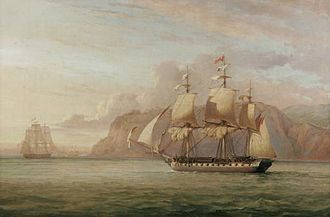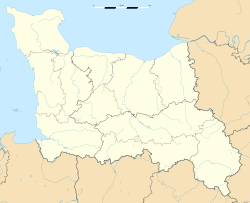Action of 24 March 1811 facts for kids
Quick facts for kids Action of 24 March 1811 |
|||||||
|---|---|---|---|---|---|---|---|
| Part of the Napoleonic Wars | |||||||
|
Map of Lower Normandy Location of the destruction of Amazone |
|||||||
|
|||||||
| Belligerents | |||||||
| Commanders and leaders | |||||||
| James Macnamara | Bernard-Louis Rosseau | ||||||
| Strength | |||||||
| Ship of the line HMS Berwick, frigates HMS Amelia, HMS Niobe, brig-sloops HMS Goshawk, HMS Hawk | Frigate Amazone | ||||||
| Casualties and losses | |||||||
| Two killed, one wounded | Amazone destroyed | ||||||
The Action of 24 March 1811 was a small but important sea battle during the Napoleonic Wars. This was a time when the Royal Navy (Britain's navy) was trying to stop French ships from using their own ports in the English Channel. By 1811, British ships were so strong that French ships found it hard to sail safely, even close to their own coast.
In late 1810, two French ships, the frigates Elisa and Amazone, tried to sail from Le Havre to join other French ships in Cherbourg-en-Cotentin. But British ships spotted them. They had to hide in Saint-Vaast-la-Hougue. There, they were attacked, and Elisa was destroyed. Amazone managed to sneak back to Le Havre in the dark. To make sure Amazone couldn't escape again, the British sent more ships to watch the port.
On the evening of March 23, 1811, Amazone left Le Havre once more, sailing west towards Cherbourg through the night. It got past the ships watching Le Havre. But at dawn on March 24, Amazone was seen near Cape Barfleur by a British warship, HMS Berwick. Berwick chased the French frigate into a bay about 1 kilometer (0.6 miles) west of the Phare de Gatteville lighthouse.
Contents
The Battle for Amazone
By the autumn of 1810, the Napoleonic Wars had been going on for seven years. The French Navy had been pushed back from the Atlantic Ocean. Now, every French port was closely watched by the Royal Navy. British ships were ready to attack any French ship that left its harbor.
In 1809, the main French fleet at Brest tried to get out into the open sea. But they were forced back and defeated at the Battle of Basque Roads. After this, much of France's naval effort focused on smaller ships. These ships, like privateers and frigate squadrons, often operated from smaller ports. These included ports on the northern coast of France in the English Channel.
The two main ports for these raids were Cherbourg and Le Havre in Normandy. Each of these ports had its own group of ships. In 1810, Cherbourg had two large warships and a new frigate called Iphigénie. The frigates Elisa and Amazone were at Le Havre.
British Blockade
British ships from the Channel Fleet watched both ports closely. Large warships were off Cherbourg. Two frigates, HMS Diana and HMS Niobe, watched Le Havre. On November 12, 1810, Elisa and Amazone tried to sneak out of Le Havre in the dark. They wanted to join the ships at Cherbourg.
They were spotted early on November 13. The frigates managed to anchor at the well-protected harbor of Saint-Vaast-la-Hougue. On November 15, British forces from Cherbourg and Le Havre attacked them. The attack was fought off, but Elisa was too damaged to continue. On November 27, Amazone successfully returned to Le Havre without meeting any British ships. Elisa was later pushed onto the shore and destroyed by the British.
Amazone's Second Escape Attempt

Amazone, led by Captain Bernard-Louis Rosseau, tried to sail to Cherbourg again on March 23, 1811. This time, Captain Rosseau successfully avoided the British ships watching Le Havre. By dawn on March 24, he was sailing past Cape Barfleur.
As the frigate passed the Phare de Gatteville lighthouse, it was only a few miles from its goal. But it was spotted by a British warship, the 74-gun HMS Berwick. Berwick was commanded by Captain James Macnamara and was about 19 kilometers (12 miles) offshore. Captain Macnamara chased Berwick, trying to cut off Amazone. The French captain managed to escape Berwick by hiding in a small bay about 1 kilometer (0.6 miles) west of the lighthouse.
Navigating through the rocks in the bay was hard. As Amazone entered the bay, its rudder was torn off. This made the ship unable to steer. With Amazone trapped, Captain Macnamara called for the rest of the British ships from the Cherbourg squadron. These included the frigate HMS Amelia (Captain Frederick Paul Irby), and the brig-sloops HMS Goshawk (Commander James Lilburn) and HMS Hawk (Commander Henry Bourchier).
These British ships had to stay far from the shore because the rocky coastline was very dangerous. Captain Macnamara planned to wait for high tide. Then, he would bring his ships closer to bombard the French frigate until it surrendered. While they waited, Niobe from the Le Havre blockade joined them.
At 4:00 PM, the tides were perfect for the attack. Niobe, Amelia, and Berwick sailed into the bay. However, Captain Rosseau had placed Amazone in a strong spot. It was protected from close attack by rocks and shallow areas. Because of this, the British ships could only fire as they turned around. This made their shots scattered and inaccurate.
As they moved forward, the British ships came under fire from Amazone. One sailor on Berwick was killed. On Amelia, one sailor was killed and another was wounded. The British fire, however, had no effect on the French ship. At 6:00 PM, Captain Macnamara pulled his ships out of the bay. All three British vessels had suffered damage to their ropes and sails from Amazone's shots.
The End of Amazone
Captain Macnamara thought about using small boats to attack Amazone directly. But he decided to try entering the bay again on the morning of March 25. As dawn broke, it became clear that Captain Rosseau had left his damaged ship with his crew. He had set the frigate on fire as they left. By the end of the day, Amazone had burned down to the waterline and was completely destroyed.
Captain Macnamara's ships then went back to their job of blocking Cherbourg. The last French frigate in the area, Iphigénie, did eventually manage to break out of Cherbourg. But it was caught and captured in the Atlantic in January 1814 during a raiding mission.
Images for kids
-
HMS Amelia, painted by John Christian Schetky in 1852.



